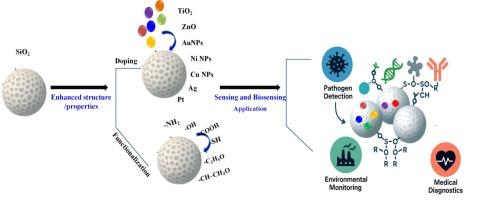增强对电化学传感器和生物传感器中掺杂和功能化二氧化硅纳米材料的识别
IF 4.9
2区 化学
Q1 CHEMISTRY, ANALYTICAL
引用次数: 0
摘要
硅基纳米材料由于其优异的化学稳定性、生物相容性和高度可调的结构特性,已成为下一代传感器和生物传感器的通用和强大的平台。通过精确控制颗粒大小、表面积和孔隙率等参数,这些材料为有效固定生物识别元件和功能基团提供了理想的支架。策略性的表面功能化和有机、无机或混合组分的靶向掺杂能够调制关键的物理化学特性,增强分析物相互作用、信号放大和整体传感器性能。此外,金属纳米颗粒、金属氧化物或碳基纳米结构的结合形成了具有更高导电性、催化活性和协同传感能力的混合结构。这些多功能材料支持广泛的检测技术,特别是电化学传感器,提供高灵敏度,选择性和操作稳定性。它们与小型化和便携式设备的兼容性进一步突出了它们在实时监测和护理点应用方面的潜力。本文章由计算机程序翻译,如有差异,请以英文原文为准。

Enhanced recognition of doped and functionalized silica nanomaterials for electrochemical sensors and biosensors
Silica-based nanomaterials have become versatile and robust platforms for next-generation sensors and biosensors due to their exceptional chemical stability, biocompatibility, and highly tunable structural characteristics. By precisely controlling parameters such as particle size, surface area, and porosity, these materials provide ideal scaffold for the effective immobilization of bio-recognition elements and functional groups. Strategic surface functionalization and targeted doping with organic, inorganic, or hybrid components enable modulation of key physicochemical characteristics, enhancing analyte interaction, signal amplification, and overall sensor performance. Moreover, the incorporation of metallic nanoparticles, metal oxides, or carbon-based nanostructures forms hybrid architectures with improved conductivity, catalytic activity, and synergistic sensing capabilities. These multifunctional materials support a broad range of detection technologies, especially electrochemical sensors that offer high sensitivity, selectivity, and operational stability. Their compatibility with miniaturized and portable devices further highlights their potential for real-time monitoring and point-of-care applications.
求助全文
通过发布文献求助,成功后即可免费获取论文全文。
去求助
来源期刊

Microchemical Journal
化学-分析化学
CiteScore
8.70
自引率
8.30%
发文量
1131
审稿时长
1.9 months
期刊介绍:
The Microchemical Journal is a peer reviewed journal devoted to all aspects and phases of analytical chemistry and chemical analysis. The Microchemical Journal publishes articles which are at the forefront of modern analytical chemistry and cover innovations in the techniques to the finest possible limits. This includes fundamental aspects, instrumentation, new developments, innovative and novel methods and applications including environmental and clinical field.
Traditional classical analytical methods such as spectrophotometry and titrimetry as well as established instrumentation methods such as flame and graphite furnace atomic absorption spectrometry, gas chromatography, and modified glassy or carbon electrode electrochemical methods will be considered, provided they show significant improvements and novelty compared to the established methods.
 求助内容:
求助内容: 应助结果提醒方式:
应助结果提醒方式:


